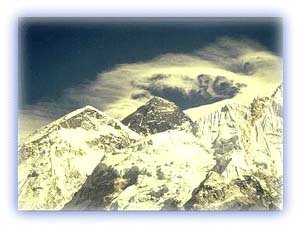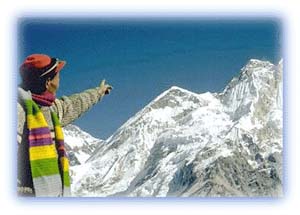Nepal Himalayas
General Info
· Solo Khumbu
· Namche Bazar
· Thyangboche
· Pangboche
· Kalapattar
· Pheriche
· Buddhism in Khumbu
· People: Sherpas
· Mount Everest
· The Quest for Everest
· Early Years
· Sherpas on Everest
· Central Nepal
· Mustang
· Jomsom
· People: Thakalis
· Muktinath
· Manang valley
· Bryagu village
· Manang village
· Nyasang Division
· Western Nepal
· Jumla
· Sukhadik
Photo Feature:
· Annapurna region
High Altitude Sickness
Endangered Species
Protected Areas
Yaks
The Yeti Factor

![]()
|
The 1950s After World War II, the Dalai Lama declared Tibet off-limits to foreigners, and mountaineers were forced to look for alternative routes to the top. Mountaineering attempts began to be made from the Nepal side of the mountain. In 1952, a Swiss expedition reached within 46 m (150 ft) of the goal. |
Question: How long will Mt. Everest continue to attract the human Spirit? (Download Realplayer) |
A British expedition was scheduled to attempt Mt Everest in 1953. This was the last chance for the British because a number of Everest expeditions from other countries were scheduled in the following years, and it was felt that one of them would surely make it to the top. The pressure to succeed was high, and this was evident as the leading British mountaineer Eric Shipton was replaced as expedition leader by the military mountaineer with a flair for organization, Colonel John Hunt. Shipton was so disappointed at the turn of events that he withdrew from the expedition altogether. Under John Hunt's leadership, a very able group of mountaineers lined up for the expedition. Edmund Hillary and George Lowe from New Zealand, Sherpa Tenzing Norgay, and others including Charles Evans, George Band and Tom Bourdillon.
 |
| Plume of clouds at the top of Everest Credit: Stan Armington |
With fantastic planning, the route was developed by setting up a number of camps. The frightening Khumbu icefall was crossed, the south face of another eight thousander, Lhotse, was traversed to reach the South Col. On the 26th of May, Charles Evans and Tom Bourdillon, using artificial oxygen, launched the first summit attempt but were pushed back less than 300 ft from the actual summit due to malfunctioning of one of their oxygen sets.
 |
| Tenzing Norgay points to that magical summit Credit: Stan Armington |
Finally came the opportunity for Tenzing Norgay and Edmund Hillary, the strongest and fittest climbers in the team. They set up a high camp above the South Col, at a breathtaking altitude of 27,900 ft above sea level, and spent a very uncomfortable night there.
Twenty-nine years after Mallory and Irvine disappeared on the higher slopes of Everest, Hillary and Tenzing made their bid for the highest point on earth. And at 11:30 am on May 29, 1953, Tenzing Norgay of Nepal/India and Edmund Hillary of New Zealand became the first men to reach the top of the loftiest mountain in the world.
South Col of Everest. (Download Realplayer) |
Tenzing, Hillary and Hunt became popular international figures. Tenzing received a hero's welcome in Nepal and India. Hillary and Hunt were knighted, while Tenzing, unfortunately, was awarded the inferior British Empire Medal.
Since that golden day in the history of mountaineering, more than 550 climbers from some 20 countries have accomplished the feat. Wang Fu-Chou in a Chinese expedition team reached the summit for the first time via the North Col. route from Tibet. Mrs Junko Tabei of Japan was the first woman to stand on the top of the world, on the 16th of May 1975, and another Japanese, Yuichiro Miura, was the first to ski back down, in 1970.
Climbers, nowadays, attempt new and difficult routes and methods. Reinhold Messner and Peter Habeler became the first men to climb Everest without the benefits of artificial oxygen on May 8, 1978. Messner returned later for a solo climb of Mt Everest -- again, without oxygen.
All rights reserved